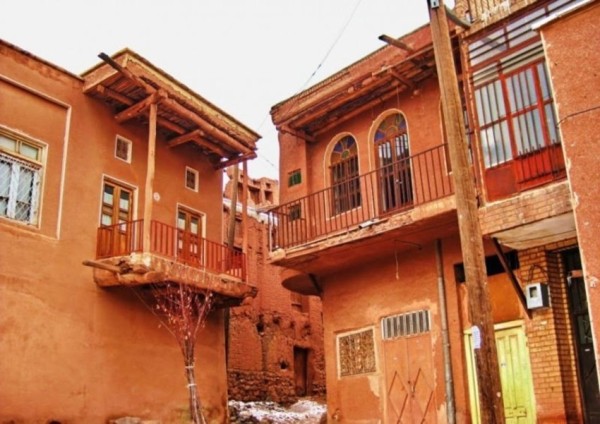
Abyaneh village
Abyaneh is a village in Barzrud Rural District of the Central District of Natanz County, Isfahan province, Iran.
At the 2006 National Census, its population was 305 in 160 households. The following census in 2011 counted 294 people in 173 households. The latest census in 2016 showed a population of 301 people in 147 households. It was the largest village in its rural district.
Since June 2005, the village has been undergoing archaeological excavations for the first time ever, as a result of an agreement between Abyaneh Research Center and the Archaeology Research Center of the Iranian Cultural Heritage and Tourism Organization (ICHTO).
Abyaneh village is one of the most specific villages of Iran with a good sight and climate, an appropriate natural situation where all the houses has been constructed on the hillside at the north of the Barzrood River with a beautiful and pleasant architecture. The form of village houses are limaceous, adobe, brick and stone related to Sassanid, Seljuk, Safavid and Qajar eras and there is no dead end alley in this village. The old houses of village have been built with the coverage of red soil, which are highly protected against the rain, on the hillside.
In addition to the tourist and historical attractions of this village such as, natural sights, house’s architecture, historical and religious places including fire temple, mosque, shrines and castles, Rose oil extraction (End of Ordibehesht), the custom of this tourist village which is greatly important for local people is also the cause of attracting tourists to this region. Jame mosque of Abyaneh is one of the oldest historical monuments with a highly beautiful wooden and wood carving pulpit.
Architecture of Abyaneh
One of the amazing things that you will definitely find interesting in Abyaneh is its architecture, making it one of the top three touristic villages in Iran along with Masouleh and Kandovan. Abyaneh has stair-shape houses, meaning that the houses were built in a way that the roof of the lower house is also the yard for the above house! Isn’t it fascinating? Not to mention the usage of clay in houses that gives the village a vibrant and lively look. Maybe these exclusivities evolved the unique culture of Abyaneh as well, the closeness and sharing of neighbors with the passion and warmness of red color.
Culture and Lifestyle in Abyaneh
Abyaneh people have their unique culture, completely different from any other place nearby. They have their own accent, clothes, house, and traditions. Besides the architectural differences that have mentioned, clothing is another cultural element that you will notice instantly. It is commonly thought that they are older people who preserve the traditions, but not in Abyaneh case! People in Abyaneh, from all age ranges, wear the village traditional clothes; even little children.
Women Clothing in Abyaneh includes dress, Shaliteh (a kind of skirt), scarf, headband, socks, footwear, or Giveh (is a kind of soft, comfortable, durable, and hand-woven-top shoe common in several parts of Iran). The dress is loose and long. Shaliteh is a loose skirt that is tied with a waistband and so many pleats. Accordingly, 7 to 8 meters of cloth is used for a skirt. The clothes they use in Shaliteh is mostly made of colorful canvas or cotton. Additionally, they use special, colorful, and shiny ribbons and stripes that they sew on the skirt (Called “Navar Douzi” and “Roban Douzi” in Persian). They also use square shape scarfs (1.5*1.5 meter square) and they fold and put on the triangle shaped scarf. Men have special clothes as well. They wear long loose black trousers.


